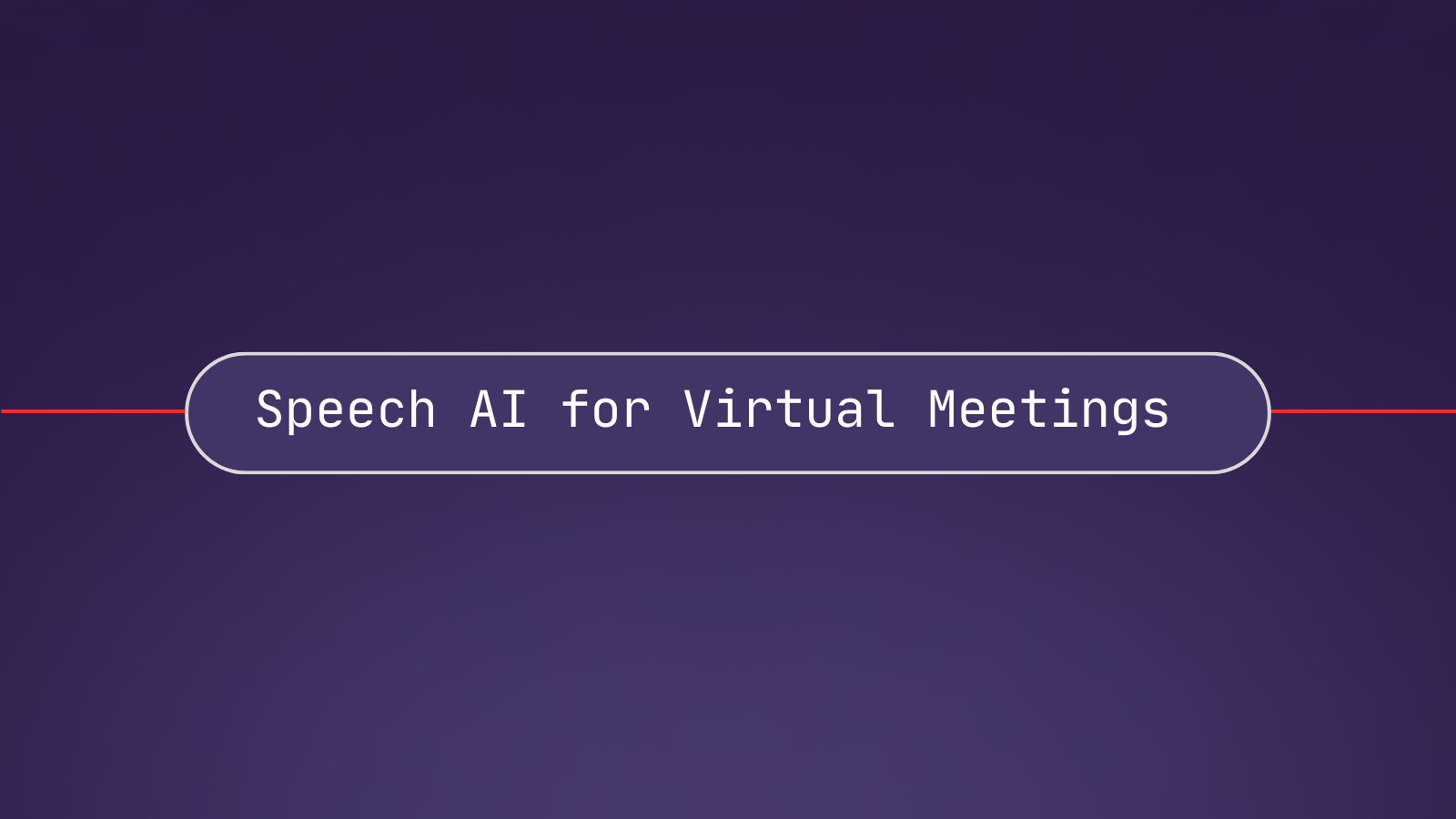Virtual meeting platforms like Zoom are commonplace in many people’s lives—from telehealth appointments with a doctor to virtual meetings for work.
Despite the consistent usage of virtual meeting solutions, a study by Owl Labs found that only 37% of companies upgraded their virtual meeting technology. Instead, employers are focused on creating more productive work environments with 63% of survey respondents saying their company trained employees on how to hold effective hybrid meetings.
While training on meeting best practices can be helpful, it only gets companies so far. Virtual meeting platforms should consider how to make their users’ experiences with their meeting software more productive to boost usage and market share. How do you enhance users’ experience with virtual meetings? One way is to incorporate Speech AI.
Speech AI, which includes Automatic Speech Recognition (ASR) (commonly known as speech-to-text), Audio Intelligence models, and LLMs, can be particularly useful for virtual meetings to transcribe conversations at scale, provide meeting notes, and offer insights on those meetings. If your virtual meeting software isn’t using speech AI, your users are missing out on many time-saving features that increase productivity and improve meeting utility.
3 Ways Virtual Meeting Companies Can Leverage Speech AI
There’s a lot of opportunity to alleviate manual work when it comes to virtual meetings and employees agree. The 2023 study from Owl Labs found that 48% of survey respondents selected AI or AI assistant as the future technology that employees would like their employers to adopt in the next two years.
Here are a few ways that virtual meeting companies can provide additional value to users and take some of that manual labor off of their plates.
Accurately transcribe meetings
With Speech-to-Text AI, virtual meeting software users can record calls and automatically transcribe those calls to text, making it easy to:
- Create a record library: Stay organized with comprehensive records of virtual meetings.
- Search conversation history: Review past conversations to understand common patterns. This can, for example, help customer support teams identify the most frequently asked questions.
- Build documentation: Users can easily create documentation of a recording, making it simple to craft onboarding materials, written tutorials, and how-to guides.
Additional Audio Intelligence models such as Auto Chapters and Entity Detection can help further organize a user’s content, providing easy ways to categorize and digest information.
Create customized meeting summaries
Meeting summaries can be a helpful productivity hack, keeping those in the loop that missed the meeting and creating an easy way to look back and refresh an attendee’s memory of what was discussed.
If virtual meeting software integrates summarization models, users can receive a summary of their recorded calls. AssemblyAI’s summarization models, for example, allow companies to leverage three different types of summarization, optimized on the use case.
- Informational: Users can summarize files such as a presentation. The informational summary is best for single speakers.
- Conversational: This model is trained specifically on conversational data and is best for summarizing conversations between multiple people.
- Catchy: If someone is conducting a virtual interview, the catchy model could be useful for crafting an engaging article or press release title.
The summaries can then be specialized further by labeling whether or not you’d like a headline, paragraph, or bullet points (more options are listed below). This can be incredibly helpful for virtual meeting users to quickly create recaps of their calls.
- gist: 3-10 word summary
- headline: about 20 word summary (1-2 sentences)
- Paragraph: 30-100 word summary (3-5 sentences)
- Bullets: Bulleted list of paragraph summaries (max of 6)
- bullets_verbose: Same as bullets, but there is no limit on the number of bullets
Provide action items and insights
Taking the summarization model a step further, businesses can build with Large Language Model (LLM) frameworks like LeMUR, to give users of virtual meeting software action items and insights on spoken data.
Action Items
With LeMUR, action items can be automatically generated from virtual meetings. The action items can be customized by requesting a specific format and can be assigned to particular meeting attendees.
Questions & Answer
Businesses have so much recorded video data, and by leveraging an LLM framework like LeMUR, virtual meeting companies can provide users with insights into their recordings, helping them identify common patterns and insights on historical data.
Users could ask questions and give prompts such as:
- What is a potential customer’s meeting history with the sales team?
- What is the most common question asked in customer success video meetings?
- Define a topic that was discussed within a meeting.
- What was discussed in the quarterly company meeting yesterday?
How Virtual Meeting Companies Build With Speech AI: Examples
Let’s look at how real companies have built tools using Speech AI models.
How Sembly AI transcribes at near-human levels
Sembly AI is an AI assistant for meetings, transcribing virtual meetings, taking notes, and providing insights. Users can sync Sembly with their Google calendar for Sembly to join the user’s virtual calls. Sembly then provides a recording, call summary, and outline after the call.
Sembly AI leverages AssemblyAI’s Conformer-2 ASR model to accurately transcribe and power their advanced AI features.
Read more: How Sembly AI leverages Speech AI
How Milk Video extracts insights from virtual meetings
Milk Video is a video marketing platform that uses AssemblyAI to both transcribe virtual meetings and also document key insights and create action items. Milk Video uses the following features for their video recordings:
- Entity Detection allows Milk Video to categorize content being described within the virtual meetings, such as names of people, organizations, and phone numbers.
- Auto Chapters organizes spoken content into time-stamped chapters making it easy for users to find specific information.
How Grain summarizes meetings with ease
Grain, which offers AI-powered meeting recordings, integrates AssemblyAI’s Speech-to-Text model to receive highly accurate meeting transcripts and automatically generate meeting summaries from each recording. Users can then copy and share key meeting insights with other team members.
Read more: How Grain uses AI Speech-to-Text
Integrate Speech AI Into Your Virtual Meeting Software
As employees and companies navigate hybrid work settings, virtual meeting platforms should consider how to make their software more valuable to end users.
To add features to your platform that improve your user’s experience, explore full-feature Speech AI recognition models. Look for models that can help you transcribe meetings, create customized meeting summaries, and provide action items for end users.
If you’re debating whether to build or buy a Speech AI recognition model, explore the pros and cons in our blog post, Should I build or buy an AI speech recognition system? to understand what direction is best for your company.







